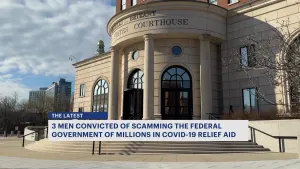Gov. Cuomo: Progress made in microclusters but red zones remain in Brooklyn, mid-Hudson
While areas in Queens will be moving from red to orange, the red zones in Brooklyn and the mid-Hudson region will remain unchanged.
•
Oct 21, 2020, 10:25 PM
•
Updated 1,731 days ago
Share:
More Stories
0:22

Cold Spring Village Hall closed due to COVID-19 surge and staff shortages
312ds ago
Hometown Heroes in the Hudson Valley
359ds ago1:28

Medical experts recommend to still take precautions following CDC's revised COVID isolation guidelines
503ds ago1:52

Judge: 3 men convicted in COVID-19 relief aid fraud
524ds ago1:47

Wondrous Things store in Briarcliff Manor to close after 34 years; everything 25% off
651ds ago0:28

Rockland small businesses get COVID-19 reimbursement grant
652ds ago0:22

Cold Spring Village Hall closed due to COVID-19 surge and staff shortages
312ds ago
Hometown Heroes in the Hudson Valley
359ds ago1:28

Medical experts recommend to still take precautions following CDC's revised COVID isolation guidelines
503ds ago1:52

Judge: 3 men convicted in COVID-19 relief aid fraud
524ds ago1:47

Wondrous Things store in Briarcliff Manor to close after 34 years; everything 25% off
651ds ago0:28

Rockland small businesses get COVID-19 reimbursement grant
652ds agoThe red zone microclusters are showing improvement,
according to COVID-19 infection data provided by the state.
Gov. Andrew Cuomo provided an
update Wednesday morning on how the different zones would be adjusted based on
the percentage of infections in those areas.
According to the governor:
- In order to exit a red zone, the area must be under 3%
infection rate for 10 days. In less populated areas, it's 4%.
- To exit an orange zone, the area must be under 2% after 10
days, 3% in less populated areas.
- To exit a yellow zone, the area must be under 1.5% after
10 days, 2% in less populated areas.
During the last week of September, the infection rates were:
- Brooklyn: 7.7%
- Queens: 4.1%
- Far Rockaway: 3.2%
- Rockland: 13.1%
- Orange: 34.2%
In the past seven days, the infection rate has been:
- Brooklyn: 5.5%
- Queens: 2.5%
- Far Rockaway: 1.8%
- Rockland: 4.2%
- Orange: 4.5%
While areas in Queens will be moving from red to orange, the
red zones in Brooklyn and the mid-Hudson region will remain unchanged.
Town of Ramapo Supervisor Michael B. Specht declined to comment on the ongoing restrictions.
Rockland County Executive Ed Day says, “It’s clear if we abide by the restrictions and continue to take preventative actions, we will soon reach the metric required to exit a red zone.”
Rockland County has received more than 40 complaints since ordering residents to wear face coverings. So far, three violations have been issued.
Gov. Cuomo says he believes more microclusters will come in
New York during the fall season, and he doesn’t believe vaccines will be
available this December.
He urged New Yorkers not to be “fatigued” by COVID-19 and to
remain vigilant against the virus.
The governor also said that New Jersey and Connecticut would
remain off the travel advisory list despite a rise in cases.
“States are not set up to do border control,” he said,
stating that their inclusion would create an economic problem and would be
“impossible.”
More from News 12
1:46

Police ask for public's help to find men caught on camera in Montgomery smoke shop robbery
2:12

Nice to not so nice weekend weather in the Hudson Valley
1:36

Nanuet Public Library is closed after damage from Monday's storm
1:48

County officials respond to Tiktok users urging people not to visit Playland Park
0:30

Police: Man pulled into MRI machine by necklace dies from his injuries
1:57
